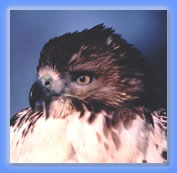The OFA is the only official organization representing the majority of licensed falconers in the State of Ohio. Over the years the OFA has worked closely with the Ohio Division of Wildlife to insure the responsible practice of falconry in Ohio.
- Hunting in Ohio – Typically, most Ohio falconers pursue rabbits and squirrels with their hawks, though some pursue other legal gamebird species such as pheasants, quail, and ducks. Like all other Ohio hunters, Ohio falconers also have to follow the hunting rules and regulations established each year, such as obtaining proper licenses, and adhering to legal bag limits, attire, and seasons.
- Ohio Hawks – Over half of Ohio falconers use Red-tailed Hawks.
 Most of these are immature passage hawks trapped during migration under federal and state permits. Harris’ Hawks are the second most popular hawk employed in the sport in Ohio, with hybrid falcons, Goshawks, Kestrels, and Cooper’s Hawks making up the balance. Many of these hawks are acquired via out-of-state trapping or commercial breeders.
Most of these are immature passage hawks trapped during migration under federal and state permits. Harris’ Hawks are the second most popular hawk employed in the sport in Ohio, with hybrid falcons, Goshawks, Kestrels, and Cooper’s Hawks making up the balance. Many of these hawks are acquired via out-of-state trapping or commercial breeders. - Hunting Statistics– According to the data collected by the Ohio Division of Wildlife in 2000 there we a total of 58 licensed falconers in Ohio (not all of these will possess a hawk at any given time). Between 1991 and 2000, each active Ohio falconer averaged approximately 30 hunting trips per season. During that time an average of 33 hawks per year were in the care of Ohio falconers and an average of 27 falconers hunted each year. The highest hunting efficiency was for rabbit-hunting hawks with 0.34 rabbits taken each trip. Statewide the average number of rabbits taken by all falconers combined was 275. The second highest hunting efficiency was for gray squirrels and fox squirrels with 0.017 and 0.013, respectively, being taken each hunting trip. Statewide the average number of gray squirrels and fox squirrels taken by all falconers combined was 13 and 12, respectively. Numbers of all other species of legal game taken were considerably less. These data generally reflect extremely low numbers of legal game currently being harvested by falconers.
- Hunting Impact– The data indicate that given the small number of falconers involved and the relatively low hunting efficiency of their hawks there is no significant impact on natural populations of legal game statewide.
- Falconry Emphasis– Compared to other forms of hunting, falconry has relatively low efficiency of taking game. Rather than racking up numbers of game, falconers focus on maximizing the time in the field with their hawks, keeping them in good hunting condition, and exposing them to as many opportunities to pursue game as possible. Fostering a mutually beneficial relationship between the falconer and their hawk is the primary emphasis in falconry.
